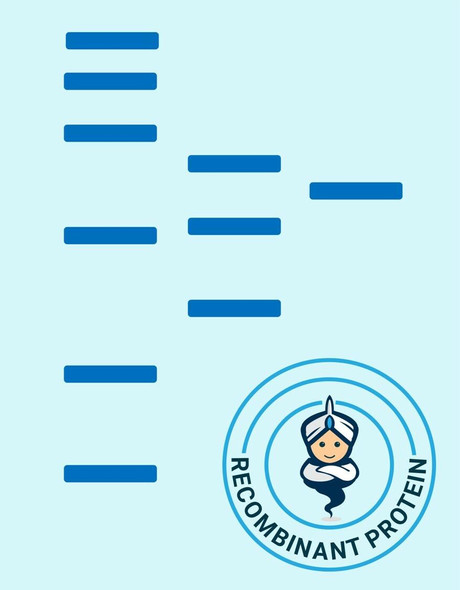Description
| Product Name: | Human PEX26 Recombinant Protein |
| Product Code: | RPPB4227 |
| Size: | 20µg |
| Species: | Human |
| Target: | PEX26 |
| Synonyms: | PBD7A, PBD7B, PEX26M1T, Pex26pM1T, Peroxisome assembly protein 26, PEX26. |
| Source: | Escherichia Coli |
| Physical Appearance: | Sterile Filtered clear solution. |
| Formulation: | The PEX26 solution (0.5mg/ml) contains 20mM Tris-HCl buffer (pH 8.0), 0.15M NaCl, 20% glycerol and 1mM DTT. |
| Stability: | Store at 4°C if entire vial will be used within 2-4 weeks. Store frozen at -20°C for longer periods of time. For long term storage it is recommended to add a carrier protein (0.1% HSA or BSA).Avoid multiple freeze-thaw cycles. |
| Purity: | Greater than 90% as determined by SDS-PAGE. |
| Amino Acid Sequence: | MGSSHHHHHH SSGLVPRGSH MGSMKSDSST SAAPLRGLGG PLRSSEPVRA VPARAPAVDL LEEAADLLVV HLDFRAALET CERAWQSLAN HAVAEEPAGT SLEVKCSLCV VGIQALAEMD RWQEVLSWVL QYYQVPEKLP PKVLELCILL YSKMQEPGAV LDVVGAWLQD PANQNLPEYG ALAEFHVQRV LLPLGCLSEA EELVVGSAAF GEERRLDVLQ AIHTARQQQK QEHSGSEEAQ KPNLEGSVSH KFLSLPMLVR QLWDSAVSH |
Peroxisomal Biogenesis Factor 26 (PEX26) which is a part of the peroxin-26 gene family is probably required for protein import into peroxisomes. PEX26 attaches PEX1 and PEX6 to peroxisome membranes to form heteromeric AAA ATPase complexes needed for the import of proteins into peroxisomes. Deficiencies in this gene are the cause of peroxisome biogenesis disorder complementation group 8. PBD is a group of peroxisomal disorders evolving from a failure of protein import into the peroxisomal membrane or matrix.
PEX26 Human Recombinant produced in E. coli is a single polypeptide chain containing 269 amino acids (1-246) and having a molecular mass of 29.3kDa. PEX26 is fused to a 23 amino acid His-tag at N-terminus & purified by proprietary chromatographic techniques.
| UniProt Protein Function: | PEX26: Probably required for protein import into peroxisomes. Anchors PEX1 and PEX6 to peroxisome membranes, possibly to form heteromeric AAA ATPase complexes required for the import of proteins into peroxisomes. Involved in the import of catalase and proteins containing a PTS2 target sequence, but not in import of proteins with a PTS1 target sequence. Defects in PEX26 are the cause of peroxisome biogenesis disorder complementation group 8 (PBD-CG8); also known as PBD-CGA. PBD refers to a group of peroxisomal disorders arising from a failure of protein import into the peroxisomal membrane or matrix. The PBD group is comprised of four disorders: Zellweger syndrome (ZWS), neonatal adrenoleukodystrophy (NALD), infantile Refsum disease (IRD), and classical rhizomelic chondrodysplasia punctata (RCDP). ZWS, NALD and IRD are distinct from RCDP and constitute a clinical continuum of overlapping phenotypes known as the Zellweger spectrum. The PBD group is genetically heterogeneous with at least 13 distinct genetic groups as concluded from complementation studies. Defects in PEX26 are a cause of Zellweger syndrome (ZWS). ZWS is a fatal peroxisome biogenesis disorder characterized by dysmorphic facial features, hepatomegaly, ocular abnormalities, renal cysts, hearing impairment, profound psychomotor retardation, severe hypotonia and neonatal seizures. Death occurs within the first year of life. Defects in PEX26 are a cause of adrenoleukodystrophy neonatal (NALD). NALD is a peroxisome biogenesis disorder characterized by the accumulation of very long-chain fatty acids, adrenal insufficiency and mental retardation. Defects in PEX26 are a cause of infantile Refsum disease (IRD). IRD is a mild peroxisome biogenesis disorder. Clinical features include early onset, mental retardation, minor facial dysmorphism, retinopathy, sensorineural hearing deficit, hepatomegaly, osteoporosis, failure to thrive, and hypocholesterolemia. The biochemical abnormalities include accumulation of phytanic acid, very long chain fatty acids (VLCFA), di- and trihydroxycholestanoic acid and pipecolic acid. Belongs to the peroxin-26 family.Protein type: Membrane protein, integralChromosomal Location of Human Ortholog: 22q11.21Cellular Component: integral to peroxisomal membrane; peroxisomeMolecular Function: protein C-terminus binding; protein binding; protein complex binding; ATPase bindingBiological Process: protein import into peroxisome matrix; protein import into peroxisome membraneDisease: Peroxisome Biogenesis Disorder 7b; Peroxisome Biogenesis Disorder 7a (zellweger) |
| UniProt Protein Details: | |
| NCBI Summary: | This gene belongs to the peroxin-26 gene family. It is probably required for protein import into peroxisomes. It anchors PEX1 and PEX6 to peroxisome membranes, possibly to form heteromeric AAA ATPase complexes required for the import of proteins into peroxisomes. Defects in this gene are the cause of peroxisome biogenesis disorder complementation group 8 (PBD-CG8). PBD refers to a group of peroxisomal disorders arising from a failure of protein import into the peroxisomal membrane or matrix. The PBD group is comprised of four disorders: Zellweger syndrome (ZWS), neonatal adrenoleukodystrophy (NALD), infantile Refsum disease (IRD), and classical rhizomelic chondrodysplasia punctata (RCDP). Alternatively spliced transcript variants have been identified for this gene. [provided by RefSeq, Dec 2010] |
| UniProt Code: | Q7Z412 |
| NCBI GenInfo Identifier: | 8923625 |
| NCBI Gene ID: | 55670 |
| NCBI Accession: | |
| UniProt Secondary Accession: | Q7Z412 |
| UniProt Related Accession: | Q7Z412 |
| Molecular Weight: | 34 kDa |
| NCBI Full Name: | peroxisome assembly protein 26 isoform a |
| NCBI Synonym Full Names: | peroxisomal biogenesis factor 26 |
| NCBI Official Symbol: | PEX26�� |
| NCBI Official Synonym Symbols: | PBD7A; PBD7B; PEX26M1T; Pex26pM1T�� |
| NCBI Protein Information: | peroxisome assembly protein 26 |
| UniProt Protein Name: | Peroxisome assembly protein 26 |
| UniProt Synonym Protein Names: | Peroxin-26 |
| Protein Family: | Peroxisome assembly protein |
| UniProt Gene Name: | PEX26�� |
| UniProt Entry Name: | PEX26_HUMAN |






